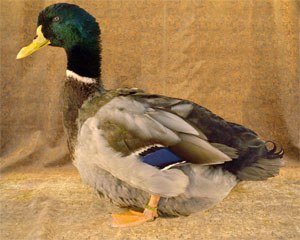Rouen Ducks
 The Rouen was developed in France a couple hundred years ago. The Mallard duck is
the ancestor of almost all domestic breeds of ducks and clearly that of the Rouen.
Though marked with the same color pattern as Mallards, with the drakes having green
heads, white collars, claret breast and a blue patch on the wing, Rouens are even
brighter in color and larger in size than Mallards. The Rouen was developed in France
and was admitted to the American Standard in 1874. It is still considered the superior
meat bird in Europe, where much more duck is consumed than in America. In the U.S.,
Rouens are raised primarily for the restaurant market. These ducks are excellent foragers,
calm in disposition and unlikely to fly. Drakes mature at about 8 pounds and ducks
at about 7 pounds. Laying rate varies; some strains average 100 eggs per year and
others over 150.
The Rouen was developed in France a couple hundred years ago. The Mallard duck is
the ancestor of almost all domestic breeds of ducks and clearly that of the Rouen.
Though marked with the same color pattern as Mallards, with the drakes having green
heads, white collars, claret breast and a blue patch on the wing, Rouens are even
brighter in color and larger in size than Mallards. The Rouen was developed in France
and was admitted to the American Standard in 1874. It is still considered the superior
meat bird in Europe, where much more duck is consumed than in America. In the U.S.,
Rouens are raised primarily for the restaurant market. These ducks are excellent foragers,
calm in disposition and unlikely to fly. Drakes mature at about 8 pounds and ducks
at about 7 pounds. Laying rate varies; some strains average 100 eggs per year and
others over 150.
Status
Watch. The Rouen is one of the more common non-commercial ducks in the U.S. Its market seems to be growing since it produced leaner meat than the Pekin, the standard commercial duck in the U.S. Exhibition Rouens do not have the production qualities that production types do.
References
The Livestock Conservancy PO Box 477, 33 Hillsboro St, Pittsboro, NC 27312
